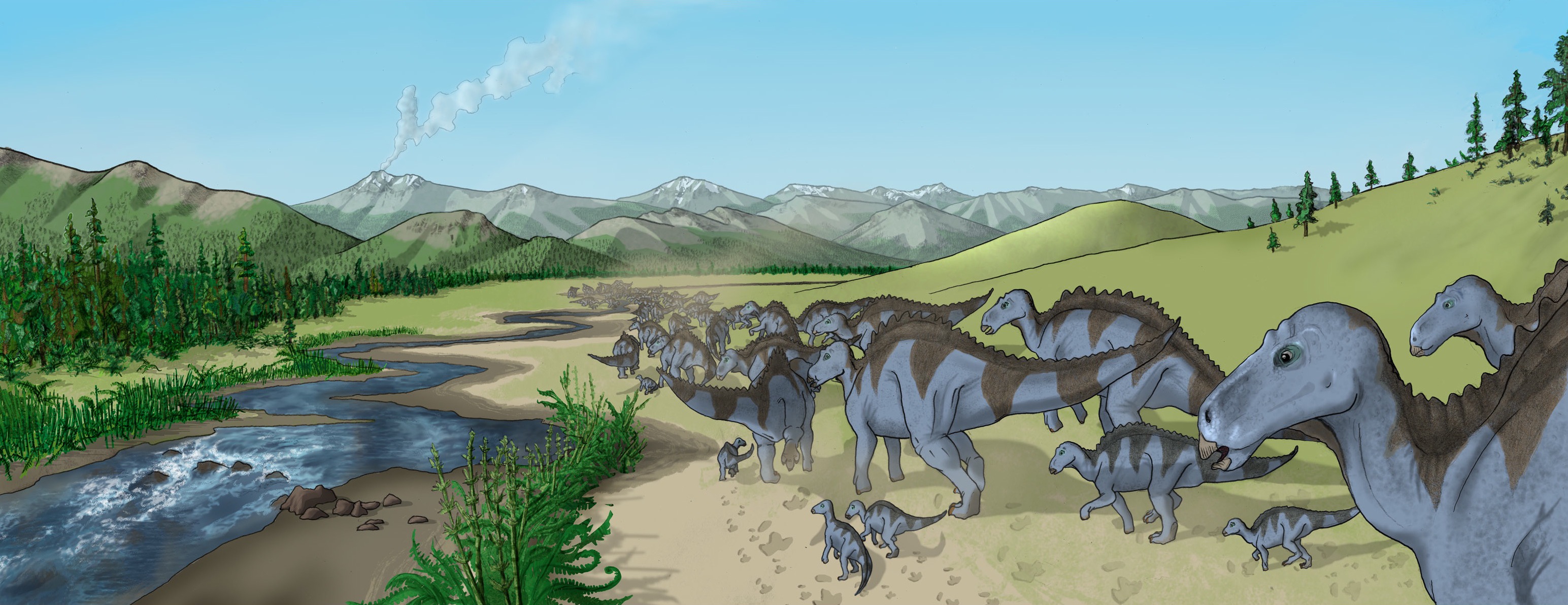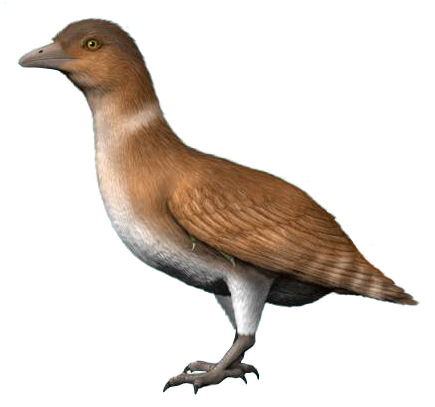|
Gettyia
''Gettyia'' is an extinct genus of avisaurid enantiornithean bird from the Late Cretaceous of North America. Description ''Gettyia'' is known from a single right tarsometatarsus. This bone was similar to that of other North American avisaurids such as ''Avisaurus'' and ''Mirarce'', but it was much smaller. The second metatarsal had a tubercule (knob-like structure) on its front edge, which likely connected to the ''tibialis cranialis'' muscle which flexes the ankle. Other avisaurids typically had this tubercule located midway on the shaft of the metatarsal, or closer to the ankle than the toes. ''Gettyia'', on the other hand, had its ''tibialis cranialis'' tubercule located more than halfway down the shaft. The third and fourth metatarsals are more extensively fused than in other avisaurids, as fusion occurs not only near the ankle, but also near the toes. Paleobiology The more distally placed ''tibialis cranialis'' tubercule of ''Gettyia'' suggests that it had a more spe ... [...More Info...] [...Related Items...] OR: [Wikipedia] [Google] [Baidu] |
Enantiornithes
The Enantiornithes, also known as enantiornithines or enantiornitheans in literature, are a group of extinct avialans ("birds" in the broad sense), the most abundant and diverse group known from the Mesozoic era. Almost all retained teeth and clawed fingers on each wing, but otherwise looked much like modern birds externally. Over eighty species of Enantiornithes have been named, but some names represent only single bones, so it is likely that not all are valid. The Enantiornithes became extinct at the Cretaceous–Paleogene boundary, along with Hesperornithes and all other non-avian dinosaurs. Discovery and naming The first Enantiornithes to be discovered were incorrectly referred to modern bird groups. For example, the first known species of Enantiornithes, ''Gobipteryx minuta'', was originally considered a paleognath related to ostriches and tinamou. The Enantiornithes were first recognized as a distinct lineage, or "subclass" of birds, by Cyril A. Walker in 1981. Walker mad ... [...More Info...] [...Related Items...] OR: [Wikipedia] [Google] [Baidu] |
Avisauridae
Avisauridae is a family of extinct enantiornithine dinosaurs from the Cretaceous period, distinguished by several features of their ankle bones. Depending on the definition used, Avisauridae is either a broad and widespread group of advanced enantiornithines (following Cau & Arduini, 2008), or a small family within that group, restricted to species from the Late Cretaceous of North and South America (following Chiappe, 1992). Description Avisaurids were among the largest and last enantiornithines to have lived, although they are also among the most poorly preserved. The majority of them are known primarily from fossilized tarsometatarsal bones, the part of a bird's leg formed by fused metatarsals (the bones which comprise the foot in humans). As a result, members of this family are distinguished from other enantiornithines exclusively by features of the tarsometatarsal and pedal phalanges (toe bones). Unlike in some prehistoric birds, avisaurid tarsometatarsals were not comple ... [...More Info...] [...Related Items...] OR: [Wikipedia] [Google] [Baidu] |
Avisaurids
Avisauridae is a family of extinct enantiornithine dinosaurs from the Cretaceous period, distinguished by several features of their ankle bones. Depending on the definition used, Avisauridae is either a broad and widespread group of advanced enantiornithines (following Cau & Arduini, 2008), or a small family within that group, restricted to species from the Late Cretaceous of North and South America (following Chiappe, 1992). Description Avisaurids were among the largest and last enantiornithines to have lived, although they are also among the most poorly preserved. The majority of them are known primarily from fossilized tarsometatarsal bones, the part of a bird's leg formed by fused metatarsals (the bones which comprise the foot in humans). As a result, members of this family are distinguished from other enantiornithines exclusively by features of the tarsometatarsal and pedal phalanges (toe bones). Unlike in some prehistoric birds, avisaurid tarsometatarsals were not co ... [...More Info...] [...Related Items...] OR: [Wikipedia] [Google] [Baidu] |
Two Medicine Formation
The Two Medicine Formation is a geological formation, or rock body, in northwestern Montana and southern Alberta that was deposited between and (million years ago), during Campanian (Late Cretaceous) time. It crops out to the east of the Rocky Mountain Overthrust Belt, and the western portion (about thick) of this formation is folded and faulted while the eastern part, which thins out into the Sweetgrass Arch, is mostly undeformed plains. Below the formation are the nearshore (beach and tidal zone) deposits of the Virgelle Sandstone, and above it is the marine Bearpaw Shale. Throughout the Campanian, the Two Medicine Formation was deposited between the western shoreline of the Late Cretaceous Interior Seaway and the eastward advancing margin of the Cordilleran Overthrust Belt. The Two Medicine Formation is mostly sandstone, deposited by rivers and deltas. History of research In 1913 in paleontology, 1913, a US Geological Survey crew headed by Eugene Stebinger and a US Nationa ... [...More Info...] [...Related Items...] OR: [Wikipedia] [Google] [Baidu] |
Avisaurus
''Avisaurus'' (meaning "bird lizard") is a genus of enantiornithine bird from the Late Cretaceous of North America. Discovery ''Avisaurus archibaldi'' was discovered in the Late Cretaceous Hell Creek Formation of North America (Maastrichtian, from c.70.6-66 million years ago), making it one of the last enantiornithids. It was collected in 1975 in the UCMP locality V73097, in Garfield County, Montana, USA. The holotype is represented by a single fossil of a tarsometatarsus in the collection of the University of California Museum of Paleontology. It has the catalog number UCMP 117600. The species name honors J. David Archibald, its discoverer, from The University of California, Berkeley. It was initially described as the left tarsometatarsus of a non-avian theropod by Brett-Surman and Paul in 1985. It was later redescribed as the right tarsometatarsus of an enantiornithine bird by Chiappe in 1992.Chiappe, Luis M. (1992) "Enantiornithine (Aves) Tarsometatarsi and the Avian Affinities ... [...More Info...] [...Related Items...] OR: [Wikipedia] [Google] [Baidu] |
Late Cretaceous
The Late Cretaceous (100.5–66 Ma) is the younger of two epochs into which the Cretaceous Period is divided in the geologic time scale. Rock strata from this epoch form the Upper Cretaceous Series. The Cretaceous is named after ''creta'', the Latin word for the white limestone known as chalk. The chalk of northern France and the white cliffs of south-eastern England date from the Cretaceous Period. Climate During the Late Cretaceous, the climate was warmer than present, although throughout the period a cooling trend is evident. The tropics became restricted to equatorial regions and northern latitudes experienced markedly more seasonal climatic conditions. Geography Due to plate tectonics, the Americas were gradually moving westward, causing the Atlantic Ocean to expand. The Western Interior Seaway divided North America into eastern and western halves; Appalachia and Laramidia. India maintained a northward course towards Asia. In the Southern Hemisphere, Australia and Ant ... [...More Info...] [...Related Items...] OR: [Wikipedia] [Google] [Baidu] |
Late Cretaceous Birds Of North America
Late may refer to: * LATE, an acronym which could stand for: ** Limbic-predominant age-related TDP-43 encephalopathy, a proposed form of dementia ** Local-authority trading enterprise, a New Zealand business law ** Local average treatment effect, a concept in econometrics Music * ''Late'' (album), a 2000 album by The 77s * Late!, a pseudonym used by Dave Grohl on his ''Pocketwatch'' album * Late (rapper), an underground rapper from Wolverhampton * "Late" (song), a song by Blue Angel * "Late", a song by Kanye West from ''Late Registration'' Other * Late (Tonga), an uninhabited volcanic island southwest of Vavau in the kingdom of Tonga * "Late" (''The Handmaid's Tale''), a television episode * LaTe, Oy Laivateollisuus Ab, a defunct shipbuilding company * Late may refer to a person who is Dead See also * * * ''Lates'', a genus of fish in the lates perch family * Later (other) * Tardiness * Tardiness (scheduling) In scheduling, tardiness is a measure of a delay in exe ... [...More Info...] [...Related Items...] OR: [Wikipedia] [Google] [Baidu] |
Fossil Taxa Described In 2018
A fossil (from Classical Latin , ) is any preserved remains, impression, or trace of any once-living thing from a past geological age. Examples include bones, shells, exoskeletons, stone imprints of animals or microbes, objects preserved in amber, hair, petrified wood and DNA remnants. The totality of fossils is known as the ''fossil record''. Paleontology is the study of fossils: their age, method of formation, and evolutionary significance. Specimens are usually considered to be fossils if they are over 10,000 years old. The oldest fossils are around 3.48 billion years old to 4.1 billion years old. Early edition, published online before print. The observation in the 19th century that certain fossils were associated with certain rock strata led to the recognition of a geological timescale and the relative ages of different fossils. The development of radiometric dating techniques in the early 20th century allowed scientists to quantitatively measure the abso ... [...More Info...] [...Related Items...] OR: [Wikipedia] [Google] [Baidu] |
Campanian Life
The Campanian is the fifth of six ages of the Late Cretaceous Epoch on the geologic timescale of the International Commission on Stratigraphy (ICS). In chronostratigraphy, it is the fifth of six stages in the Upper Cretaceous Series. Campanian spans the time from 83.6 (± 0.2) to 72.1 (± 0.2) million years ago. It is preceded by the Santonian and it is followed by the Maastrichtian. The Campanian was an age when a worldwide sea level rise covered many coastal areas. The morphology of some of these areas has been preserved: it is an unconformity beneath a cover of marine sedimentary rocks. Etymology The Campanian was introduced in scientific literature by Henri Coquand in 1857. It is named after the French village of Champagne in the department of Charente-Maritime. The original type locality was a series of outcrop near the village of Aubeterre-sur-Dronne in the same region. Definition The base of the Campanian Stage is defined as a place in the stratigraphic column wher ... [...More Info...] [...Related Items...] OR: [Wikipedia] [Google] [Baidu] |
Mirarce
''Mirarce'' (meaning "wonderful winged messenger") is a genus of enantornithe bird from the Late Cretaceous of Utah. It contains a single species, ''M. eatoni''.Science NewsMirarce eatoni: Newly-Discovered Cretaceous Bird Lived Among Dinosaurs, Was Strong Flier November 13, 2018. It was similar in size to modern turkeys. Discovery In 1992, in Utah, USA, paleontologist Howard Hutchison discovered fossilized remains of an enantiornithine bird. For a long time they have not been described; they were sometimes figured under the unofficial name of "Kaiparowits enantiornithine". The holotype, UCMP 139500, is well preserved in three dimensions. It consists of a partial postcranial skeleton without a skull, including 3 cervical and 2 thoracic vertebrae, a pygostyle, a furcula, the xiphoid process of the sternum, a fragment of the left scapula and a coracoid, the humerus, ulna, and radius with fragments of the manus, several fused fragments of the pelvic girdle, and some elements of ... [...More Info...] [...Related Items...] OR: [Wikipedia] [Google] [Baidu] |
Campanian
The Campanian is the fifth of six ages of the Late Cretaceous Epoch on the geologic timescale of the International Commission on Stratigraphy (ICS). In chronostratigraphy, it is the fifth of six stages in the Upper Cretaceous Series. Campanian spans the time from 83.6 (± 0.2) to 72.1 (± 0.2) million years ago. It is preceded by the Santonian and it is followed by the Maastrichtian. The Campanian was an age when a worldwide sea level rise covered many coastal areas. The morphology of some of these areas has been preserved: it is an unconformity beneath a cover of marine sedimentary rocks. Etymology The Campanian was introduced in scientific literature by Henri Coquand in 1857. It is named after the French village of Champagne in the department of Charente-Maritime. The original type locality was a series of outcrop near the village of Aubeterre-sur-Dronne in the same region. Definition The base of the Campanian Stage is defined as a place in the stratigraphic column wher ... [...More Info...] [...Related Items...] OR: [Wikipedia] [Google] [Baidu] |





